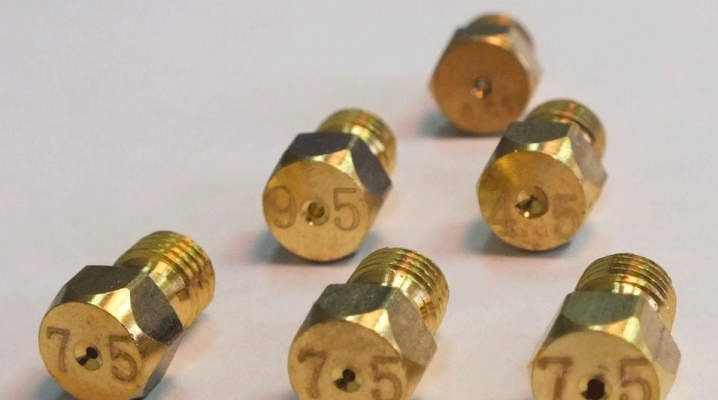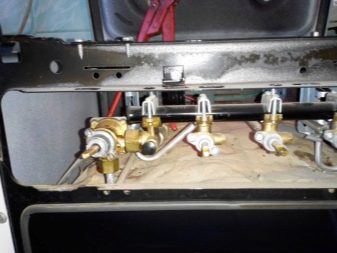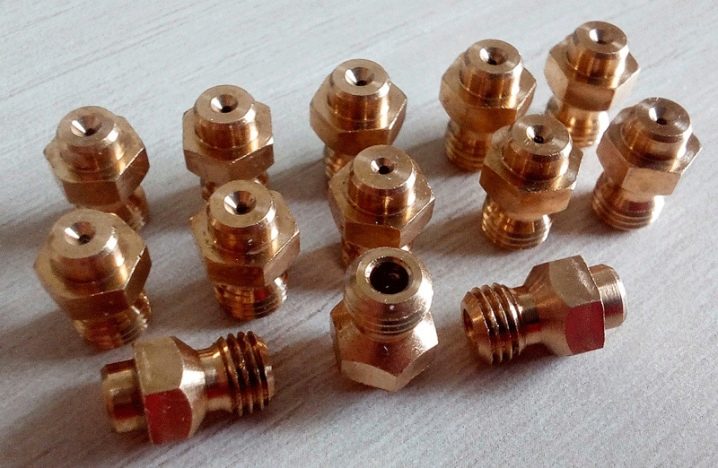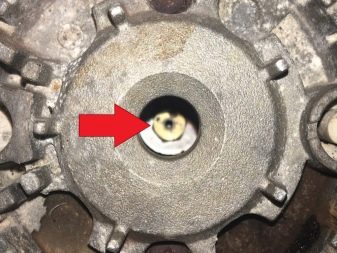Jets for gas stoves: features and subtleties of replacement

A gas stove is a household appliance. Its purpose is to convert gaseous fuel into thermal energy by burning the latter. It is worth considering what jets for gas stoves are, what are their features and subtleties of replacement.

What it is?
The principle of operation of a gas stove has a certain algorithm. Pressurized gas is supplied to the gas pipeline system, which is part of the stove. By opening the shut-off valve located on the front panel, blue fuel moves towards the combustion point. In this section, depending on the design of a particular model, gas and air are mixed, which provides optimal conditions for ignition. At the end point, flame diffusers are installed, enabling it to burn in a stable mode.

Gaseous fuel can be supplied via the mains pipeline or in a liquefied state in special cylinders. In most cases, network and liquefied gases are one and the same substance. However, the methods of their delivery to the final consumer affect the combustion properties and the conditions under which the latter becomes possible.
For the stable operation of the gas stove when using this or that type of fuel, it is necessary to install the appropriate components - jets.


The gas stove jets are replaceable parts for the stove burner. Their main function is to supply fuel to the combustion point in the required volume under the appropriate pressure. The jets are equipped with a through hole, the diameter of which determines the parameters of the gas "jet". The size of the hole in each specific type of jets is designed for a certain pressure in the gas pipeline system. The characteristics of the latter differ significantly depending on the method of supply and the type of fuel - natural or liquefied (propane).
To ensure stable and efficient operation of the gas stove, eliminate smoking factors and prevent the release of harmful combustion products, it is necessary to install jets on the gas stove, the dimensions of which correspond to the conditions specified by the manufacturer.
Types and characteristics
Jets are bolt-type nozzles. They have a hexagonal head slot and an external thread, and are made mainly of bronze. They are provided with a longitudinal hole. A marking is applied to the end part indicating the throughput of the jet in cubic centimeters per minute.


On the stove, which operates from a cylinder source of fuel, nozzles with a smaller diameter should be installed. This is because the pressure in the cylinder is much higher than that used in a conventional gas network. If the diameter of the orifice of the nozzle exceeds the permissible value, that amount of gas will pass through it, which will not be able to completely burn out. This factor entails the formation of soot on the dishes and the release of harmful combustion products. A gas burner connected to the mains gas supply is equipped with jets with a smaller opening. The lower pressure coefficient in the network causes the corresponding amount of fuel to pass through this hole.

Each gas stove is supplied with an additional set of jets. If there is no such one, and the need to replace them is inevitable, you should not resort to self-alteration of the nozzles by drilling the hole.
These components are manufactured using high-precision instruments. The accuracy of the hole diameter is determined by microns, which negates the effectiveness of self-upgrading of the nozzles.
In order to replace the jets, you need to purchase the appropriate set of those. To find out the parameters of the nozzles required when using a particular method of fuel supply and suitable for a particular model of gas stove, you can refer to the technical documentation supplied with the equipment.

The ratio of the diameters of the nozzles to the pressure value is as follows:
- small burner - 0.75 mm / 20 bar; 0.43 mm / 50 bar; 0.70 mm / 20 bar; 0.50 mm / 30 bar;
- medium burner - 0.92 mm / 20 bar; 0.55 mm / 50 bar; 0.92 mm / 20 bar; 0.65 mm / 30 bar;
- large burner - 1.15 mm / 20 bar; 0.60 mm / 50 bar; 1.15 mm / 20 bar; 0.75 mm / 30 bar;
- oven burner - 1.20 mm / 20 bar; 0.65 mm / 50 bar; 1.15 mm / 20 bar; 0.75 mm / 30 bar;
- grill burner - 0.95 mm / 20 bar; 0.60 mm / 50 bar; 0.95 mm / 20 bar; 0.65 mm / 30 bar.
Important! In some cases, the intermittent operation of the nozzles may be caused by a blockage in the outlet. In such a situation, the problem is solved not by replacing, but by cleaning the jets.
How do I clean the injectors?
It is recommended to periodically clean or change the nozzles - this is an integral part of the maintenance procedures that must be carried out at least once a year. A delay in cleaning leads to a deterioration in the combustion of the flame: the appearance of yellow tints, smoking, a decrease in the heat coefficient and other undesirable consequences. In order to clean the nozzles, you will need the following:
- cleaning products: vinegar, soda, or detergent;
- old toothbrush;
- thin needle.




Cleaning is done as follows:
- the area where the jet is located is cleaned of carbon deposits, grease, plaque and other foreign substances;
- the nozzle is removed - it can be unscrewed using a union head of the corresponding diameter, equipped with an extension (the jet can be located at the depth of the body, which makes it difficult to unscrew it with a conventional wrench);
- the object of cleaning is soaked in a solution of soda, vinegar or a cleaning agent for a while (depending on the degree of pollution);
- the outer surface is cleaned with a toothbrush with the application of a cleaning kitchen powder;
- the inner hole is cleaned with a thin needle; in some cases, purging with a compressor or pump is effective (an automobile is sufficient).
After cleaning is complete, the jet needs to dry well. At the end of drying, its hole should be visible through the lumen, and there should be no foreign debris in it. Reinstallation of the injector is carried out in the opposite sequence to the analysis. If there was a gasket under the jet, replace it with a new one.
Replacement procedure
For a successful replacement, a preparatory study is required. As part of it, find out the following:
- what type of fuel is supported by the installed jets;
- what are the parameters of the alternative nozzles for this plate model;
- what kind of fuel is supplied to the gas system.
Important! Before installing new components, you must turn off the gas supply and open all the burners to drain the residual fuel from the system.


Hotplates
Worth sticking to the following algorithm of actions:
- to free them from all foreign objects: grates, "bumpers" of the flame;
- remove the top panel that covers the gas supply system to the burners; it can be fixed with special clamps or bolts;
- unscrew the nozzles installed in the stove at the moment;
- replace the O-ring, if provided by the manufacturer;
- lubricate new nozzles with graphite grease, which is designed to lubricate parts that are heated to high temperatures;
- screw the nozzles into their landing places, tighten with sufficient force;
- reassemble the plate panel in the reverse order.





In the oven
The principle of replacing the nozzle in the oven is identical to the process described above. Differences in the procedure are reduced to the difference in the design of the oven for each specific model of the stove and looks like this:
- provide access to the inside of the oven - open the door, remove the rack-shelf and the like;
- remove the bottom panel - "floor" of the oven; in most cases, it is not bolted, but inserted into the grooves;
- find and unscrew all the fastening points of the burner located under the "floor", sometimes its fasteners are located at the bottom; they are accessed through the bottom drawer of the stove, intended for storing kitchen utensils;
- after removing the burner, the jet will be in an accessible position for dismantling.


After replacement, the nozzles are checked for leaks. The fuel supply is switched on, the seats of the jets are covered with soapy water or dishwashing liquid or shampoo.
If the formation of bubbles is observed at the point of contact of the nozzle with the seat, carry out a "stretch".
If there is no result, replace the O-ring again and fix its correct position before screwing in the nozzle. Re-lubricate the thread. Make sure that there are no debris in its grooves.

You can change the jets with your own hands, but these manipulations with a household appliance that are under warranty will cancel it. If possible, you should contact a qualified specialist. The master will change the jets in the prescribed manner and take responsibility for the safe and uninterrupted operation of the gas stove throughout the entire period of operation.
How to replace the jets in the gas stove yourself, see the video below.













The comment was sent successfully.